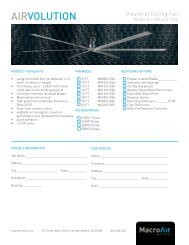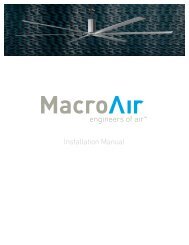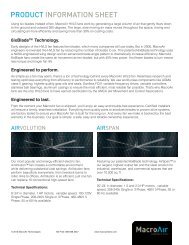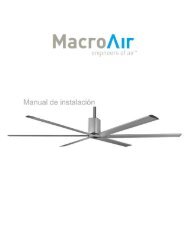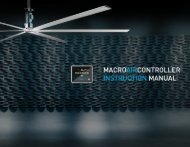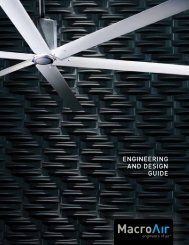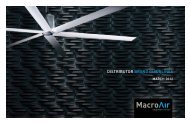How HVLS Fan Technology Works - MacroAir HVLS Fans
How HVLS Fan Technology Works - MacroAir HVLS Fans
How HVLS Fan Technology Works - MacroAir HVLS Fans
You also want an ePaper? Increase the reach of your titles
YUMPU automatically turns print PDFs into web optimized ePapers that Google loves.
<strong>How</strong> <strong>HVLS</strong> <strong>Fan</strong> <strong>Technology</strong> <strong>Works</strong>
Introduction<br />
Energy is expensive – especially when it comes to heating and cooling. Whether you do business<br />
in the northeast or the south, you’re most likely looking for ways to lower your energy<br />
costs. In addition, businesses are under the gun from federal, state, and even supply chain<br />
partners and customers to lower their carbon footprint and implement and develop “green”<br />
practices and products. Wal-mart’s stated objective, for example, is to “accelerate change towards<br />
sustainability,” which means that any company doing business with Wal-mart will have<br />
to show demonstrable eco-improvements – whether it’s in the manufacturing of goods or the<br />
distribution and warehousing of these goods.<br />
In this white paper you’ll learn about the history of <strong>HVLS</strong> fan technology, the physics of airflow,<br />
and why energy efficient <strong>HVLS</strong> fans can help you lower your energy costs.<br />
<strong>How</strong> <strong>HVLS</strong> <strong>Fan</strong> <strong>Technology</strong> <strong>Works</strong> © 2011 <strong>MacroAir</strong> Technologies, Inc. | macro-air.com 2
History of <strong>HVLS</strong> <strong>Fan</strong>s<br />
Dairy cattle stop eating when they suffer from heat stress. When they don’t eat, milk production<br />
slows or comes to a halt – a bottom-line breaking challenge for dairy farmers in an<br />
already highly competitive business. Previous to 1995, dairy farmers used small high-speed<br />
fans to help keep cattle cool. These fans helped but posed their own challenges: they didn’t<br />
cover a wide enough area, were considerably inefficient, consumed excessive and costly energy,<br />
and required ongoing maintenance. They also had a short mechanical life.<br />
Taking advantage of the laws of physics, Walter Boyd designed a large overhead fan that<br />
moved a large volume of air gently down to the ground and outward 360 degrees. This large,<br />
slow moving air mass moved throughout the barn, continuously mixing incoming fresh air<br />
with stale air and minimizing the amount of ventilation required to achieve good air quality.<br />
Most importantly, the new fan design cooled the cows without causing them stress due to excessive<br />
noise or kick-up of dust – and thus increased milk production. The first High Volume,<br />
Low Speed (<strong>HVLS</strong>) barn fan models used 10 airfoil blades that incorporated design characteristics<br />
developed at NASA.<br />
<strong>How</strong> <strong>HVLS</strong> <strong>Fan</strong>s Work – The Laws of Physics<br />
You don’t need a physics degree to know that a breeze moving across your skin on a hot day<br />
feels good, especially in humid environments. The cool moving air breaks up the moisturesaturated<br />
boundary layer surrounding the body – accelerating evaporation to produce a cooling<br />
effect. People have been using fans to cool themselves long before the advent of the electric<br />
motor; it was logical then, that fans would be one of the first things to be mechanized.<br />
At some point however, engineers became so focused on using speed to increase fan displacement<br />
– the cubic feet of air per minute (CFM) moved through a fan – that some important<br />
physics-based issues were overlooked. While having a cool breeze brush over our hot<br />
skin feels good, high velocity air movement is both unpleasant and disruptive. And, air speed<br />
beyond four or five miles per hour usually offers little, if any, additional cooling benefit as very<br />
slow moving air actually cools best in very hot, high humidity conditions.<br />
Small high-speed fans create a pressure differential that’s essential for many applications, but<br />
where slow movement of free air is the objective, pressure differential is not important. Therefore,<br />
displacement, the amount of air that actually moves through the fan, is of no real significance.<br />
It’s the down-stream effects that are important.<br />
A turbulent, high velocity air jet dissipates very quickly. A large column of air, however, “travels”<br />
farther than a small one. The friction between moving air and stationary air occurs at the<br />
periphery of the moving column. The perimeter of a column varies directly with column<br />
<strong>How</strong> <strong>HVLS</strong> <strong>Fan</strong> <strong>Technology</strong> <strong>Works</strong> © 2011 <strong>MacroAir</strong> Technologies, Inc. | macro-air.com 3
diameter. And while the cross-sectional area varies with the square of the diameter, the large<br />
column has proportionately less periphery, and therefore less “drag.” The air column from a<br />
three-foot diameter fan has more than six times as much “friction interface” per cubic foot as<br />
does the air column from a 20-foot fan. This is why a large, slow moving fan actually cools better<br />
and more efficiently than a small high-speed fan.<br />
When the down column of air from an <strong>HVLS</strong> fan reaches the floor, the air turns in the horizontal<br />
direction away from the column in all directions. The air flowing outward is called the “horizontal<br />
floor jet.” Since the height of the floor jet is determined by the diameter of the column<br />
of air, a larger diameter fan naturally produces a larger air column and thus a higher floor jet.<br />
Smaller high-speed fans of equivalent displacement are incapable of producing the same effect.<br />
The power to drive a fan increases roughly with the cube of the average air speed through<br />
the fan. A commercial fan delivering air at 20 miles per hour (mph) requires about 64 times as<br />
much power as a similar sized fan delivering air at five mph! Airspeed, combined with fan “effectiveness,”<br />
means that when the objective is to cool people or animals, very large, low-speed<br />
commercial fans are enormously more efficient and effective than small high-speed fans.<br />
The new <strong>HVLS</strong> fan proved to be incredibly energy efficient as one <strong>HVLS</strong> fan consumed about<br />
the same amount of electricity as one high-speed fan while moving over 12 times the amount<br />
of air. A later design enhancement that added a “down wash” to the airfoil blades, in the same<br />
manner a spoiler keeps the rear wheels of a car on the road. This new addition increased airflow<br />
CFM (cubic foot per minute) by almost 30% with only a minimal increase in power consumption.<br />
<strong>How</strong> <strong>HVLS</strong> <strong>Fan</strong> <strong>Technology</strong> <strong>Works</strong> © 2011 <strong>MacroAir</strong> Technologies, Inc. | macro-air.com 4
New Advancements – Reducing the Number of Blades<br />
Extrusion is the name for the process used to manufacture objects of a fixed cross-sectional<br />
profile, including airfoil blades, plastic pipe, tubing and sheets of film, terra cotta bricks, and<br />
even food products. Basically, the material, such as plastic or metal, is heated and pushed<br />
through a die to form a specific shape. To create an <strong>HVLS</strong> fan blade, for example, an extrusion<br />
company heats up aluminum ingots, pushes the ingots through a die to create the foil, and<br />
then cuts the foil at the desired length. The larger the shape to be extruded, the more tonnage<br />
and capacity is required by the extruder.<br />
As extrusion capacities increased, <strong>HVLS</strong> fan engineers began experimenting with larger airfoil<br />
shapes – something they couldn’t do when the first <strong>HVLS</strong> fans were created. Creating a<br />
larger airfoil wasn’t simply the answer to improving efficiency. The airfoil must work efficiently<br />
through a range of speeds, and engineers have to take into account that as the <strong>HVLS</strong> fan rotates,<br />
the end of the blade moves faster than it does at its fixed point at the fan hub. In addition,<br />
engineers had to consider airflow patterns and what happens when air hits the floor.<br />
Due to the laws of physics, a larger airfoil shape means that fewer fan blades are required to<br />
achieve optimal performance; fewer blades also reduce torque (the tendency of a force to rotate<br />
an object about an axis, fulcrum, or pivot). <strong>Fan</strong> longevity is related to torque:<br />
Horsepower = Torque * Revolutions Per Minute (RPM)<br />
5252<br />
As RPM goes up, torque goes down for the same horsepower. An <strong>HVLS</strong> fan that has fewer<br />
blades rotates slightly faster, which lowers torque. Since torque is a constant stress on a fan’s<br />
motor, bearings and gear, less torque means longer fan life.<br />
Fewer blades also means reduces the manufacturing carbon footprint. The electrolysis process<br />
used to produce aluminum requires large quantities of electrical power. When the cost of producing<br />
one ton of primary aluminum is broken down, almost one third is devoted to electrical<br />
power. The amount of electrical power needed to produce an <strong>HVLS</strong> fan with fewer blades is less<br />
than what’s needed to produce a 10-blade fan.<br />
<strong>How</strong> <strong>HVLS</strong> <strong>Fan</strong> <strong>Technology</strong> <strong>Works</strong> © 2011 <strong>MacroAir</strong> Technologies, Inc. | macro-air.com 5
Measuring fan speed performance<br />
<strong>Fan</strong> speed performance is measured using CFM (cubic feet per minute) or the measurement<br />
of volume over time: the higher a fan’s CFM number, the higher the volume or capacity of the<br />
fan. To measure the performance of an <strong>HVLS</strong> fan, engineers generally use the method approved<br />
by the Air Movement and Control Association (AMCA) and measure “thrust,” which is<br />
the force the fan produces as a result of the air being pushed through it. The higher the thrust<br />
value, the higher the volume of air and fan performance or CFM – as seen in the table below:<br />
<strong>Fan</strong> Size<br />
10-Blade <strong>HVLS</strong> <strong>Fan</strong><br />
8 ft 39,000 CFM 2<br />
10 ft 74,122 CFM 3<br />
12 ft 91,285 CFM 3<br />
1<br />
AMCA Certified CFM<br />
2<br />
Derived from Certified Thrust Data for Comparison<br />
3<br />
CFM data not AMCA certified<br />
<strong>How</strong> <strong>HVLS</strong> <strong>Fan</strong> <strong>Technology</strong> <strong>Works</strong> © 2011 <strong>MacroAir</strong> Technologies, Inc. | macro-air.com 6
About <strong>MacroAir</strong> Technologies, Inc.<br />
<strong>MacroAir</strong> developed and introduced the first <strong>HVLS</strong> 10-blade fan prototype in 1998.<br />
<strong>MacroAir</strong> Technologies, Inc.<br />
794 South Allen Street<br />
San Bernardino, CA 92408<br />
T: 866-668-3247<br />
Email: sales@macro-air.com<br />
Web: www.macro-air.com<br />
Follow Us!<br />
Blog: www.macro-air.com/basement/blog<br />
Twitter: @<strong>MacroAir</strong>Tech<br />
Facebook: facebook.com/<strong>MacroAir</strong><br />
<strong>How</strong> <strong>HVLS</strong> <strong>Fan</strong> <strong>Technology</strong> <strong>Works</strong> © 2011 <strong>MacroAir</strong> Technologies, Inc. | macro-air.com 7




